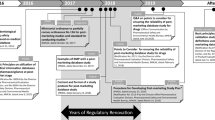Abstract
Background
Risk minimization activities are planned and conducted as part of a drug’s risk management plan; additional risk minimization activities are implemented as needed in consideration of the regulations and medical environment in each country/region, as well as drug-specific factors.
Objective
The present study was conducted with the aim of investigating the status of implementing additional risk minimization activities in Europe, the USA, and Japan and understanding the characteristics of such activities commonly conducted in these countries/regions.
Methods
For new drugs approved between 2013 and 2017, the status of implementing the additional activities was investigated based on the information published on each of the regulatory agencies’ websites. Next, we identified drugs approved in all three countries/regions and investigated drug-specific factors such as indications and safety concerns. Furthermore, the contents of the activities were analyzed from the viewpoint of whether they intended risk mitigation or risk prevention.
Results
The status of implementing additional activities was 26.4% (42/159 drugs) in Europe, 7.6% (15/197 drugs) in the USA, and 64.8% (92/142 drugs) in Japan. Forty-five drugs that were approved in all three countries/regions were identified. Many drugs with additional activities displayed novel mechanisms of action in therapeutic areas such as oncology. Common additional activities were implemented for only three drugs and for two of these drugs, “teratogenicity” was identified as a safety concern subjected to additional activities.
Conclusions
Risk minimization activities were considered to be largely influenced by differences in regulatory thinking, medical systems, such as the number of healthcare providers per patient and the insurance system, and cultural differences. For drugs with a risk for teratogenicity and those with side effects that differ from conventional therapies, there was a tendency to commonly implement additional activities.


Similar content being viewed by others
References
Council for International Organizations of Medical Sciences. Introduction, scope and background. In: Practical approaches to risk minimisation for medicinal products: report of CIOMS Working Group IX. Geneva; 2014. p. 1–8.
Council for International Organizations of Medical Sciences. International regulatory context and background. In: Practical approaches to risk minimisation for medicinal products: report of CIOMS Working Group IX. Geneva; 2014. p. 9–23.
European Medicines Agency. Guideline on good pharmacovigilance practices. Module V: risk management systems (Rev 2). 2017. https://www.ema.europa.eu/en/documents/scientific-guideline/guideline-good-pharmacovigilance-practices-module-v-risk-management-systems-rev-2_en.pdf. Accessed 22 Mar 2019.
European Medicines Agency. Guideline on good pharmacovigilance practices (GVP). Module XVI: risk minimisation measures: selection of tools and effectiveness indicators (Rev 2). 2017. https://www.ema.europa.eu/en/documents/scientific-guideline/guideline-good-pharmacovigilance-practices-module-xvi-risk-minimisation-measures-selection-tools_en-3.pdf. Accessed 22 Mar 2019.
Directors of Safety Division and Director of Evaluation and Licensing Division, Pharmaceutical and Food Safety Bureau, Ministry of Health, Labor and Welfare. Risk management plan guidance. 2012. https://www.pmda.go.jp/files/000153333.pdf. Accessed 22 Mar 2019.
US Food and Drug Administration. Risk evaluation and mitigation strategies (REMS). https://www.fda.gov/Drugs/DrugSafety/REMS/default.htm. Accessed 22 Mar 2019.
Centre for Innovation in Regulatory Science. New drug approvals in ICH countries 2004–2013: focus on 2013. http://cirsci.org/publications/CIRS_R&D_Briefing_54_%20ICH_approval_times_2004-2013_22apr2014.pdf. Accessed 22 Mar 2019.
Centre for Innovation in Regulatory Science. New drug approvals in ICH countries 2005-2014: focus on facilitated regulatory pathways orphan designations. http://cirsci.org/sites/default/files/CIRS_R&D_57_ICH_%20approval_%20times_2005-2014_%2006072015.pdf. Accessed 22 Mar 2019.
Centre for Innovation in Regulatory Science. New active substances (NASs) approved by six major authorities in 2015. http://www.cirsci.org/wp-content/uploads/2016/06/CIRS_-RD_-Briefing_-59_Supplement_-NAS-list_-23052016-1.pdf. Accessed 22 Mar 2019.
Centre for Innovation in Regulatory Science. New drug approvals in ICH countries 2007–2016. http://www.cirsci.org/wp-content/uploads/2017/04/ICH-Approval-times-CIRS-Briefing-62-FINAL-18042017.pdf. Accessed 22 Mar 2019.
Centre for Innovation in Regulatory Science. New active substances (NASs) approved by six major authorities in 2017. http://www.cirsci.org/wp-content/uploads/2017/11/CIRS-RD-Briefing-65-NAS-list-24102017.pdf. Accessed 22 Mar 2019.
Council for International Organizations of Medical Sciences. Principles of identification tools. In: Practical approaches to risk minimisation for medicinal products: report of CIOMS Working Group IX. Geneva; 2014. p. 25–41.
Council for International Organizations of Medical Sciences. Annex I glossary. In: Practical approaches to risk minimisation for medicinal products: report of CIOMS Working Group IX. Geneva; 2014. p. 93–108.
Acknowledgements
We extend our sincere appreciation to Rei Maeda, Kazuhiro Ishida, Kou Miyakawa, Shachiyo Tanaka, Tomoko Yamada, and Yoko Hijioka for their helpful professional advice. We thank Editage (www.editage.jp) for English language editing.
Author information
Authors and Affiliations
Corresponding author
Ethics declarations
Funding
No funding has been received for the conduct of this study or preparation of this article.
Conflict of interest
Yuka Yasuoka is an employee of BMSKK, a subsidiary of Bristol-Myers Squibb, Princeton, NJ, USA. Masayuki Kaneko and Mamoru Narukawa have no conflicts of interest that are directly relevant to the content of this article.
Ethics approval
This article does not contain any studies with human participants or animals performed by any of the authors.
Electronic supplementary material
Below is the link to the electronic supplementary material.
Rights and permissions
About this article
Cite this article
Yasuoka, Y., Kaneko, M. & Narukawa, M. Evaluation of the Implementation of Additional Risk Minimization Activities in Europe, the USA, and Japan. Pharm Med 33, 417–424 (2019). https://doi.org/10.1007/s40290-019-00303-1
Published:
Issue Date:
DOI: https://doi.org/10.1007/s40290-019-00303-1



